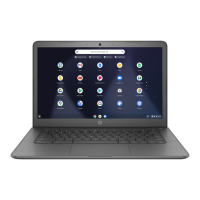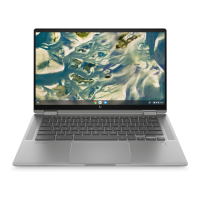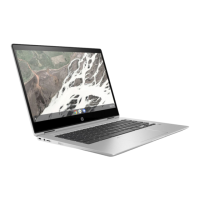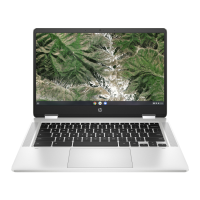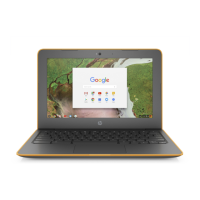
Do you have a question about the HP Elite C1030 Chromebook and is the answer not in the manual?
| Operating System | Chrome OS |
|---|---|
| RAM | 8GB or 16GB LPDDR3 |
| Storage | 128GB, 256GB, or 512GB SSD |
| Battery Life | Up to 12 hours |
| Ports | 1 x headphone/microphone combo |
| Wireless | Intel Wi-Fi 6 AX201 (2x2) and Bluetooth 5 combo |
| Graphics | Intel UHD Graphics |
| Display | 13.5" diagonal, FHD+ (1920 x 1280), IPS, anti-glare, 400 nits, 100% sRGB; 13.5" diagonal, FHD+ (1920 x 1280), IPS, anti-glare, touch, 400 nits, 100% sRGB |
Identifies components located on the right side of the computer.
Identifies components located on the left side of the computer.
Identifies components related to the computer's display.
Details about the computer's keyboard layout and variations.
Describes the touchpad settings and components.
Explains the location and function of the fingerprint reader.
Identifies and describes special keys on the keyboard.
Identifies components located on the bottom of the computer.
Explains the location and purpose of various computer labels.
Lists and illustrates the main internal components of the computer.
Lists and describes various external and accessory parts.
Lists the necessary tools for component removal and replacement.
Provides important guidelines for disassembly and assembly procedures.
Caution regarding handling plastic parts during service.
Guidelines for safely handling cables and connectors.
Specific instructions for handling computer drives.
Recommendations for setting up a safe and effective work area.
Explains the risks of ESD and its impact on electronic components.
Information on how static electricity is generated and its levels.
Precautions for preventing ESD damage to sensitive electronic components.
Describes equipment for grounding personnel to prevent static discharge.
Guidelines for creating a static-free work environment.
Lists recommended items for preventing static electricity.
Instructions for safely packaging and transporting computer equipment.
General instructions for removing and replacing computer components.
Steps to prepare the computer before disassembling it.
Procedure for removing and replacing the bottom cover.
Procedure for removing and replacing the computer's battery.
Procedure for removing and replacing the M.2 solid-state drive.
Procedure for removing and replacing the touchpad.
Procedure for removing and replacing the computer speakers.
Procedure for removing and replacing the fingerprint sensor board.
Procedure for removing and replacing the heat sink and fan assembly.
Procedure for removing and replacing the IR sensor board.
Procedure for removing and replacing the main system board.
Procedure for removing and disassembling the display assembly.
Procedure for removing and replacing the USB door.
Procedure for removing and replacing the volume button.
Procedure for removing and replacing the power button.
Procedure for removing and replacing the lock bracket.
Procedure for removing and replacing the kill switch button.
Procedure for removing the top cover with keyboard assembly.
Instructions for backing up personal data to various storage locations.
Steps for performing a factory reset on the computer.
Procedure for recovering the operating system using the recovery utility.
Guide to installing the utility for system recovery.
Steps to create recovery media for system restoration.
Process for reinstalling the OS using created recovery media.
Initial setup steps after performing a reset or recovery.
Instructions for erasing and reusing recovery media.
Provides detailed specifications for the computer's hardware and performance.
Details specific technical data for the computer's display.
Instructions for restoring nonvolatile memory via BIOS settings.
Details troubleshooting steps for nonvolatile memory.
Answers common questions regarding nonvolatile memory and BIOS.
General requirements for power cord sets applicable worldwide.
Specific power cord requirements based on country or region.



